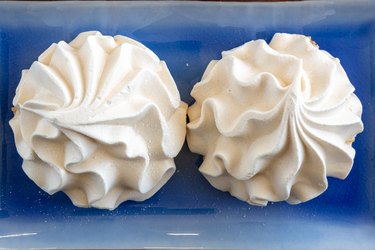
Of course, using an electric beater is the preferred way to go when making meringue. However, with the right whisk and a little muscle you can create a stiff, glossy meringue without a mixer.
The Science Behind Meringue
Video of the Day
Blending egg whites and sugar together sounds simple enough. However, the ingredients used to make a meringue may be a bit misleading. The technique used to create the light, airy confection often used to make pie shells, filled cookies and angel food cake, is as important as the ingredients.
Video of the Day
To get the right meringue consistency, sometimes referred to as a hard meringue, the liquid egg whites must be beaten to a point in which the proteins in the egg white denature, or unravel, says the American Egg Board. This process opens the normally compact, well-protected protein molecule, and exposes the water-loving (hydrophilic) and water-hating (hydrophobic) charged ends. These proteins then reconfigure themselves and create pockets of well-protected, trapped air bubbles.
When whisked to make a meringue, the liquid egg whites can increase in volume six to eight times, according to the American Egg Board. This foaming ability is due to the specific types of proteins found in the egg white: ovalbumin and ovomucin. The ovalbumin is responsible for creating the foam, while the ovomucin traps the air bubbles when cooked.
Read more: 9 Things You May Not Know About Eggs
Making a Meringue Without Mixer
According to the American Egg Board, when making the egg white foam you need to beat the egg whites until they're stiff and glossy to create the ideal meringue consistency. According to the LIVESTRONG.com recipe for Breakfast Cloud Bread, this takes about 5 minutes in your electric mixer.
Making a meringue without a mixer may take more time, but you can still get the ideal consistency. Try this recipe adapted from the Breakfast Cloud Bread recipe.
Ingredients:
- 3 egg whites at room temperature
- 1/4 teaspoon cream of tartar
- 3/4 cup sugar
Directions:
- Place the egg whites in a small glass or metal bowl and add the cream of tartar.
- Beat the egg whites with a large, fine-wire whisk, adding the sugar 2 tablespoons at a time. Beat the egg whites until stiff and glossy.
Once you've achieved the meringue consistency you want, use the egg foam to create your sweet confection.
Be sure to bake your meringue before consuming it or you may risk foodborne illness. Washington State University Extension says that you can safely consume meringue after it's been baked at 350 degrees Fahrenheit for 15 minutes.
Read more: 7 Reasons to Crack an Egg for Breakfast
Meringue Troubleshooting
Hand beating meringue is tough enough, so make sure you follow a few rules to ensure all of your muscle power is put to good use. When making meringue, the American Egg Board suggests you choose a day that's not very humid. Too much moisture in the air may make your meringue too sticky.
You also want to be very careful when separating your eggs. Any yolk in the egg whites may inhibit foaming. The same is true for the utensils you use for hand beating meringue. Any debris can affect the consistency of your meringue. Fat residue can be harder to remove from plastic bowls, which is why glass or metallic bowls are preferred.
Adding sugar too quickly can also ruin your meringue. You need to make sure each addition of sugar is fully dissolved before adding the next. You can test by rubbing a bit of your meringue between your fingers. If your meringue is gritty, keep beating. If it's smooth, add the next 2 tablespoons of sugar.
Cream of tartar helps stabilize your egg foam. But if this acidic ingredient isn't in your cupboard, you can use lemon juice or vinegar instead.